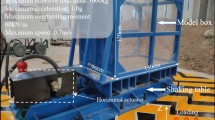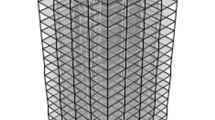Abstract
To investigate the distributing disciplinarian of ground motion parameters on the earth fissure site during strong earthquakes, a series of shaking table tests were designed and conducted based on 1:15 scaled models. Test results showed significant differences in the ground motion parameters (including ground motion intensity indices, spectrum characteristics and strong motion duration) between the hanging-wall and footwall caused by the earth fissure. Acceleration response, displacement response and Arias Intensity response on both sides of earth fissure indicated that the earth fissure site on the hanging-wall was destroyed more seriously. The distributing disciplinarian of amplification factors showed clear “hanging-wall and footwall effects”, which were more remarkable nearby the fissure zones. The low-frequency component of the seismic wave was richer after selectively filtering in the soil medium. By comparing the predominant period and mean period of the hanging-wall and footwall, it was found that vibration frequency on the hanging-wall was greater than that on the footwall. Minimum values of strong motion duration were recorded on the hanging-wall close to the fissure and increased from the fissure to both sides.
Similar content being viewed by others
References
Arias A (1970), “Measure of Earthquake Intensity,” In: Hansen RJ (ed) Seismic Design for Nuclear Power Plants, MIT Press, Cambridge, 438–483.
Ayalew L, Yamagishi H and Reik G (2004), “Ground Cracks in Ethiopian Rift Valley: Facts and Uncertainties,” Engineering Geology, 75(3): 309–324.
Bommer JJ, Udias A, Cepeda JM, Hasbun JC, Salazar WM, Suarez A, Ambraseys NN, Buform E, Cortina J, Madariage R, Mendez P, Mezcua J and Papastamatiou D (1997), “A New Digital Accelerograph Network for El Salvador,” Seismological Research Letters, 68(3): 426–436.
Cao Z, Hou L, Xu H and Yuan XM (2010), “Distribution and Characteristics of Gravelly Soil Liquefaction in the Wenchuan Ms8.0 Earthquake,” Earthquake Engineering and Engineering Vibration, 9(2): 167–175.
Chen GX, Wang ZH, Zuo X, Du X and Gao H (2013), “Shaking Table Test on the Seismic Failure Characteristics of a Subway Station Structure on Liquefiable Ground,” Earthquake Engineering & Structural Dynamics, 42(10): 1489–1507.
Chen GX, Chen S, Zuo X, Du XL, Qi CZ and Wang ZH (2015), “Shaking-Table Tests and Numerical Simulations on a Subway Structure in Soft Soil,” Soil Dynamics & Earthquake Engineering, 76:13–28.
Gaur VP, Kar SK and Srivastava M (2015), “Development of Ground Fissures: A Case Study from Southern Parts of Uttar Pradesh, India,” Journal of the Geological Society of India, 86(6): 671–678.
Geng DY and Li ZS (2000), “Ground Fissure Hazards in the USA and China,” Acta Seismologica Sinica, 13(4): 466–476.
Hao M (2006), “The Research of Physical Measure of Seismic Intensity and Damage Potential of Earthquake Ground Motions,” PhD Dissertation, Harbin Institute of Technology. (in Chinese)
Harp EL and Wilson RC (1995), “Shaking Intensity Thresholds for Rock Falls and Slides: Evidence from the Whittier Narrows and Superstition Hills Earthquake Strong Motion Records,” Bulletin of the Seismological Society of America, 85(6): 1739–1757.
Housner GW (1952), “Spectrum Intensities of Strong Motion Earthquake,” Proceedings of the Symposium on Earthquake and Blast Effects on Structures, EERI, Oakland California, 20–36.
Hu ZP, Zhao ZR, Zhu QD and Ma YP (2009), “Experimental Study on Physcal Mechanic Property of Loess Near Ground Fissure in Xi’an,” Journal of Earth Sciences & Environment, 31(1): 85–88. (in Chinese)
Hu ZP, Wang QY, Luo LJ, Ma SL and Liu AL (2014), “Shaking Table Test on Seismic Response Difference Between Primary and Secondary Ground Fissures on Sites with Y-Shape Ground Fissure,” China Civil Engineering Journal, 11: 98–107. (in Chinese)
Jachens RC and Holzer TL (1982), “Differential Compaction Mechanism for Earth Fissures Near Casa Grande, Arizona,” Geological Society of America Bulletin, 93(10): 998–1012.
Kalogirou EE, Tsapanos TM, Karakostas VG, Marinos VP and Chatzipetros A (2014), “Ground Fissures in the Area of Mavropigi Village (N. Greece): Seismotectonics or Mining Activity?” Acta Geophysica, 62(6): 1387–1412.
Kramer SL (1996), Geotechniacl Earthquake Engineering, New York: Prentice-Hall.
Leonard RJ (1929), “An Earth Fissure in Southern Arizona,” Journal of Geology, 37(8): 765–774.
Lee CF, Zhang JM and Zhang YX (1996), “Evolution and Origin of the Ground Fissures in Xi’an, China,” Engineering Geology, 43(1): 45–55.
Li YD, Jie C, Guan TD and Jing LP (2015), “Investigation into Dynamic Response of Regional Sites to Seismic Waves Using Shaking Table Testing,” Earthquake Engineering and Engineering Vibration, 14(3): 411–421.
Li YL, Yang JC and Hu XM (2000), “Origin of Ground Fissures in the Shanxi Graben System, Northern China,” Engineering Geology, 55(4): 267–275.
Liu NN, Huang QB, Men YM and Peng JB (2014), “Model Test on Dynamic Response of Ground with Fissures Under Seismic Loading,” Chinese Journal of Rock Mechanics and Engineering, 33(5): 102–1031. (in Chinese)
Liu NN, Huang QB, Ma YJ, Bulut R, Peng JB, Fan W and Men YM (2017), “Experimental Study of a Segmented Metro Tunnel in a Ground Fissure Area,” Soil Dynamics & Earthquake Engineering, 100: 410–416.
Margaris B, Athanasopoulos G, Mylonakis G, Papaioannou C, Klimis N and Theodulidis N (2010), “The 8 June 2008 Mw 6.5 Achaia-Elia, Greece Earthquake: Source Characteristics, Ground Motions, and Ground Failure,” Earthquake Spectra, 26(2): 399–424.
Masood Y, Ahmad N and Amiri GG (2015), “Optimal Vector-Valued Intensity Measure for Seismic Collapse Assessment of Structures,” Earthquake Engineering and Engineering Vibration, 14(1): 37–54.
Ngecu WM and Nyambok IO (2000), “Ground Subsidence and Its Socio-Economic Implications on the Population: a Case Study of the Nakuru Area in Nentral Rift Valley, Kenya,” Environmental Geology, 39(6): 567–574.
Pacheco-Martínez J, Hernandez-Marín M, Burbey TJ, González-Cervantes N, Ortíz-Lozano JÁ, Zermeño-De-Leon, ME and Solís-Pinto A (2013), “Land Subsidence and Ground Failure Associated to Groundwater Exploitation in the Aguascalientes Valley, México,” Engineering Geology, 164(18): 172–186.
Peng JB, Chen LW, Huang QB, Men YM, Fan W and Yan JK (2013), “Physical Simulation of Ground Fissures Triggered by Underground Fault Activity,” Engineering Geology, 155(2): 19–30.
Peng JB, He K, Tong X, Huang QB and Liu C (2016a), “Failure Mechanism of an Underground Metro Tunnel Intersecting Steep Ground Fissure at Low Angle,” International Journal of Geomechanics, 17(5): E4016006.
Peng JB, Huang QB, Hu ZP, Wang MX, Li T, Men YM and Fan W (2017), “A Proposed Solution to the Ground Fissure Encountered in Urban Metro Construction in Xi’an, China,” Tunnelling & Underground Space Technology, 61: 12–25.
Peng JB, Qiao JW, Leng YQ, Wang FY and Xu SZ (2016b), “Distribution and Mechanism of the Ground Fissures in Wei River Basin, the Origin of the Silk Road,” Environmental Earth Sciences, 75(8): 718.
Peng JB, Sun XH, Wang W and Sun GC (2016c), “Characteristics of Land Subsidence, Earth Fissures and Related Disaster Chain Effects with Respect to Urban Hazards in Xi’an, China,” Environmental Earth Sciences, 75(16): 1190.
Peng JB, Xu JS, Ma RY and Wang FY (2016d), “Characteristics and Mechanism of the Longyao Ground Fissure on North China Plain, China,” Engineering Geology, 214: 136–146.
Qu FF, Zhang Q, Lu Z, Zhao CY, Yang CS and Zhang J (2014), “Land Subsidence and Ground Fissures in Xi’an, China 2005–2012 Revealed by Multi-Band InSAR Time-Series Analysis,” Remote Sensing of Environment, 155: 366–376.
Rajendran CP, Earnest A, Rajendran K, Das RD and Kesavan S (2003), “The 13 September 2002 North Andaman (Diglipur) Earthquake: An Analysis in the Context of Regional Seismicity,” CURR SCI INDIA, 84(7): 919–924.
Rudolph DL, Cherry JA and Farvolden RN (1991), “Groundwater Flow and Solute Transport in Fractured Lacustrine Clay Near Mexico City,” Water Resources Research, 27(9): 2187–2201.
Sancio RB, Bray JD, Stewart JP, Youd TL, Durgunoğlu HT, Önalp A, Seed RB, Christensen C, Baturay MB, and Karadayılar T (2002), “Correlation Between Ground Failure and Soil Conditions in Adapazari, Turkey,” Soil Dynamics & Earthquake Engineering, 22(9–12): 1093–1102.
Stacey TR and Bell FG (1999), “The Influence of Subsidence on Planning and Development in Johannesburg, South Africa,” Environmental and Engineering Geoscience, V(4): 373–388.
Sun P, Peng JB, Chen LW, Yin YP and Wu SR (2009), “Weak Tensile Characteristics of Loess in China-an Important Reason for Ground Fissures,” Engineering Geology, 108(1): 153–159.
Tang L, Maula BH, Ling XZ and Su L (2014), “Numerical Simulations of Shake-Table Experiment for Dynamic Soil-Pile-Structure Interaction in Liquefiable Soils,” Earthquake Engineering and Engineering Vibration, 13(1): 171–180.
Tun ST, Wang Y, Khaing SN, Thant M, Htay N, Htwe YMM, Myint T and Sieh K (2014), “Surface Ruptures of the Mw 6.8 March 2011 Tarlay Earthquake, Eastern Myanmar,” Bulletin of the Seismological Society of America, 104(6): 2915–2932.
Von Thun JL, Rochim LH, Scott GA and Wilson JA (1988), Earthquake Ground Motions for Design and Analysis of Dams, New York: Earthquake Engineering and Soil Dynamics II-Recent Advances in Ground-Motion Evaluation, Geotechnical Special Publication.
Wang GY, You G, Shi B, Qiu ZL, Li HY and Tuck M (2010a), “Earth Fissures in Jiangsu Province, China and Geological Investigation of Hetang Earth Fissure,” Environmental Earth Sciences, 60(1): 35–43.
Wang GY, Guanlin You GLGY, Shi B, Wu SL and Wu JQ (2010b), “Large Differential Land Subsidence and Earth Fissures in Jiangyin, China,” Environmental Earth Sciences, 61(5): 1085–1093.
Wang JM, Wang CM and Liu K (2001), “Progress in Ground Fissures and Its Hazard Reseach, Xi’an, China,” Advance in Earth Sciences, 16(3): 303–343. (in Chinese)
Wang ZF, Shen SL, Cheng WC and Xu YS (2016), “Ground Fissures in Xi’an and Measures to Prevent Damage to the Metro Tunnel System due to Geohazards,” Environmental Earth Sciences, 75(6): 1–11.
Xiong ZM, Chen X, Zhang C, Huo XP and Zhuge Y (2017), “Shaking Table Tests of RC Frame Structure Across the Earth Fissure Under Earthquake,” Structural Design of Tall & Special Buildings, 27(14): 9–29.
Xiong ZM, Zhang C, Huo XP and Chen X (2018), “Shaking Table Tests on Acceleration Response of Ground Fissure Site,” Chinese Journal of Geotechnical Engineering, 40(3): 520–526. (in Chinese)
Zhang JM (1990), Research on Ground Fissures in Xi’an City, Xi’an: Northwest University Press. (in Chinese)
Zhang Q, Qu W, Wang QL, Peng JB, Drummond J, Li, ZH and Lin Q (2011), “Analysis of Present Tectonic Stress and Regional Ground Fissure Formation Mechanism of the Weihe Basin,” Survey Review, 43(322): 382–389.
Acknowledgment
This study was supported by the National Natural Science Foundation of China (Grant No. 51278395), the Science and Technology Project of Ministry of Housing and Urban-Rural Development of China (No. 2016-k5-044) and Key Project of Natural Science Foundation of Shaanxi Province (No. 2018JZ5008). The authors would like to sincerely thank the of Key Lab of Structure and Earthquake Resistance in Xi’an University of Architecture and Technology who conducted the shaking table test. Additionally, the special thanks go to the editor as well as the reviewers of this study, for their useful comments that improved the manuscript substantially.
Author information
Authors and Affiliations
Corresponding author
Additional information
Supported by: National Natural Science Foundation of China under Grant No. 51278395, the Science and Technology Project of Ministry of Housing and Urban-Rural Development of China under Grant No. 2016-k5-044, and Key Project of Natural Science Foundation of Shaanxi Province under Grant No. 2018JZ5008
Rights and permissions
About this article
Cite this article
Zhongming, X., Chao, Z., Xiaopeng, H. et al. Distributing disciplinarian of ground motion parameters on an earth fissure site during strong earthquakes. Earthq. Eng. Eng. Vib. 19, 597–610 (2020). https://doi.org/10.1007/s11803-020-0583-9
Received:
Accepted:
Published:
Issue Date:
DOI: https://doi.org/10.1007/s11803-020-0583-9




